历史
The University's history is linked to the development of Leeds as an international centre for the textile industry and clothing manufacture in the Victorian era. Its roots stretch back to the early nineteenth century and it was one of six civic universities in industrial cities given royal charters at the beginning of the twentieth century (beginning with Birmingham in 1900). Before this wave of expansion in higher education, only five universities--Oxford, Cambridge, London, Durham, and the federal Victoria University--were established in England and one in Wales (1893). (The Victoria University was established at Manchester in 1880 as a federal university for the North of England since the government were unwilling to raise Owens College to university status. However Owens College was the only member from 1880 to 1884; from 1887 when Yorkshire College joined there were three member colleges.)
Origins
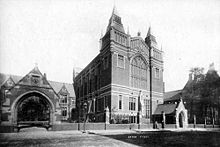
An early view of the Great Hall, next to the Clothworkers' Court
In 1831, the Leeds School of Medicine was set up, serving the needs of the five medical institutions that had sprung up in the city. Then in 1874, the School was joined by the Yorkshire College of Science, intended to provide education for the children of middle-class industrialists and merchants. Financial support from local industry was crucial (there is a Clothworkers' Court at the University to this day).
The College of Science was modelled on Owens College, Manchester, established in 1851 as a non-sectarian alternative to Oxford and Cambridge, where religious tests were applied and those outside the Church of England were not allowed to receive degrees or were barred from entry outright. Owens College, like the earlier University College London, applied no such tests and was open to Protestant Dissenters, Catholics and Jews.
While religious tests for students at Oxford and Cambridge ceased in the 1850s, northern colleges continued to promote themselves as offering a distinct type of teaching. They took pride in the progressive and pragmatic nature of their scientific education; a field in which the ancient universities, with their focus on general and classical study, were felt to lag behind.
The Yorkshire College of Science began by teaching experimental physics, mathematics, geology, mining, chemistry and biology, and soon became well known as an international centre for the study of engineering and textile technology. When classics, modern literature and history went on offer a few years later, the Yorkshire College of Science became the Yorkshire College. In 1887, the College merged with the School of Medicine.
Victoria University and royal charter
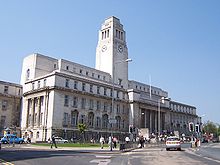
Parkinson Building, whose tower forms the University logo
Leeds was given its first university in 1887 when the Yorkshire College joined the federal Victoria University on 3 November: the Victoria University had been established by royal charter in 1880; Owens College being at first the only member college. Leeds now found itself in an educational union with close social cousins from Manchester and Liverpool.
Unlike Owens College, the Leeds section of the Victoria University had never barred women from its courses. However, it was not until special facilities were provided at the Day Training College in 1896 that women enrolled in significant numbers. The first female student to begin a course here was Lilias Annie Clark, who studied Modern Literature and Education.
The Victoria University was short-lived. Manchester and Liverpool were keen to establish independent universities, unhappy with the practical difficulties posed by maintaining a federal arrangement across broad distances, and spurred by the granting of a charter to the University of Birmingham in 1900. The University of Leeds was granted a royal charter as an independent body by King Edward VII in 1904.
Reputation and rankings
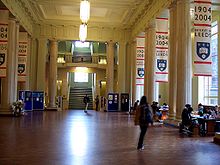
Foyer of the Parkinson Building, with banners celebrating the University's centenary
Leeds is a leading research institution, and a member of the Russell Group, a group of research-orientated universities. In the 2001 Research Assessment Exercise the University was placed seventh nationally for the number of top-scoring researchers and eighth for 'research power' out of 173 institutions taking part in the exercise. Just under 800 researchers at the university were given ratings of 5* or 5, meaning that 70 per cent of the university's researchers were working at the highest level on projects of international importance. The university received the highest 5* grade, denoting work at the forefront of international research, in six subjects: Electronic and Electrical Engineering, Mechanical Engineering, English, Town and Country Planning (i.e. Transport), Food Science, and Italian.
In The Times Higher Education Supplement rankings 2007, Leeds was placed 16th in the UK, 27th in Europe and 80th in the world.
The University has an excellent reputation for teaching and provides a wide range of courses for students. The Guardian University Guide 2008 rated it top in the country for Dentistry and Chemical Engineering, while a majority of its courses were ranked in the top ten or twenty.
The University of Leeds Business School is regarded as one of the best in the UK. In its most recent ranking the school's MBA programme was placed 15th in Europe by The Economist. In the Financial Times' Global MBA ranking for 2008, the Leeds MBA was ranked 48th in the world.
UK University Rankings
|
2010 |
2009 |
2008 |
2007 |
2006 |
2005 |
2004 |
2003 |
2002 |
2001 |
2000 |
1999 |
1998 |
1997 |
1996 |
1995 |
1994 |
1993 |
| Times Good University Guide |
27th |
31 |
30 |
35 |
38th |
34th= |
35th |
29th |
28th |
22nd |
22nd |
23rd |
22nd |
35th |
24th= |
22nd= |
10th= |
26th |
| Guardian University Guide |
27th |
20 |
25 |
17 |
41 |
32 |
20 |
|
|
|
|
|
|
|
|
|
|
| Sunday Times University Guide |
24th |
26 |
29 |
31 |
31 |
33 |
28 |
22 |
25 |
21 |
20 |
24 |
|
|
|
|
|
| Daily Telegraph |
|
|
37 |
|
|
|
22 |
|
|
|
|
|
|
|
|
|
|
| FT |
|
|
|
|
|
|
27 |
17 |
25 |
16 |
18 |
|
|
|
|
|
|
| The Independent |
32 |
37 |
|
|
|
|
|
|
|
|
|
|
|
|
|
|
|
Present Day
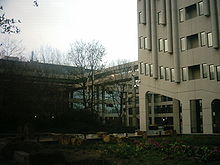
Brutalist concrete architecture within the campus
During the 2007–08 academic year, 30,500 students were attached to 700 different first-degree programmes and 470 postgraduate degree programmes. Whilst maintaining its strengths in the traditional subjects (for example more students studying languages and physical sciences than anywhere else in the UK), Leeds has also developed expertise in more distinctive and rare specialist areas such as Colour Chemistry, Fire Science, Nanotechnology and Aviation Technology with Pilot studies.
In December 2004, financial pressures forced the University's governing body (the Council) to decide to close the Bretton campus. Activities at Bretton were moved to the main University campus in the summer of 2007 (allowing all Bretton-based students to complete their studies there). There was substantial opposition to the closure by the Bretton students. The University's other satellite site, Manygates in Wakefield, also closed, but Lifelong Learning and Healthcare programmes are continuing on a new site next to Wakefield College.
In May 2006, the University began re-branding itself to bring together its visual identity to produce one consistent look. A new logo was produced, based on that used during the centenary celebrations in 2004, to replace the combined use of the modified University Crest and the old Parkinson Building, which has been in use since 2004. The University Crest will still be used in its original form for ceremonial purposes only. Individual department and service logos are also being phased out. Four university colours were also specified, being green, red, black and beige.
The University is committed to working with the private sector and invests heavily in realising the commercial potential of its academic developments. Leeds attracts the highest level of industrial funding of any university in the UK.
The University’s educational partnerships have included providing formal accreditation of degree awards to Leeds College of Art and Leeds Trinity & All Saints, although the latter is now establishing itself as a university in its own right. The College of the Resurrection, an Anglican theological college in Mirfield with monastic roots, has, since its inception in 1904, been affiliated to the University, and ties remain close. The University is also a founding member of the Northern Consortium.
校园
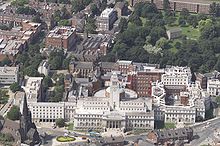
A section of the University of Leeds campus, seen from above
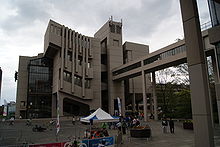
The Roger Stevens Building, one of a number of Brutalist building on campus, which are linked by a series of interconnected skyways.
The University has 1,230 acres (498 ha) of land, with the main campus taking up 98 acres (40 ha).
The main campus is located 1 mile (1.6 km) north of Leeds city centre. It is within walking distance of both the city centre and Headingley, a popular residential area for students. The main entrance to the campus for visitors by car is on Woodhouse Lane (A660), near the Parkinson Building. The tower of this building is a well-known landmark and is used in the University's logo.
In addition to the main campus, there is also a satellite location at Wakefield. Until the 2006–07 academic year, some courses were taught at the Bretton Hall campus in West Bretton. The site closed in summer 2007 after which the courses taught there were relocated to the main campus in Leeds.
There is no railway station close to the main campus, however there are numerous bus routes which serve it. The proposed Leeds Supertram would have run past the campus. The currently proposed Leeds Trolleybus (northern line) will run past the campus, linking it with the city centre, Headingley and Lawnswood. The Leeds Inner Ring Road also lies close to the campus.
Facilities
Libraries
The University Library is spread over four locations, and holds, in total, 2.78 million books, 26,000 print and electronic journals, 850 databases and 6,000 electronic books: making it one of the largest research libraries in the UK. The main arts, social sciences and law library is the Brotherton Library, located in the Parkinson Building. The main science, engineering and student library is the Edward Boyle Library, located in the centre of the campus. Medicine, dentistry and healthcare students are served by the Health Sciences Library, located in the Worsley building, and there is an extension of this library at St James's University Hospital.
The university librarians designed environmentally friendly bags after becoming concerned at the environmental effects of handing out so many plastic bags to students. The bags are imprinted with large white "Sshhh...!" on one side and the other side contains contact details for the library and the new University logo.
Computing
There are 9,000 personal computers available across the campus along with 150 Sun computers and servers, 8 high performance Sun servers and 256 supercomputers. There are 29 centrally-managed computer clusters of varying sizes spread across the different sites, along with others managed by specific departments. Five of these clusters are available 24 hours a day.
Research facilities
Many of the academic departments have specialist research facilities, for use by staff and students. These include those hosted at the Institute for Transport Studies, such as the Instrumented City and University of Leeds Driving Simulator.
Students Union
Main article: Leeds University Union
The University's student union, located on campus, includes numerous shops, bars, nightclubs and other amenities, and is one of the largest student union operations in the UK.
Leeds University Union (LUU) won the award for Higher Education Students' Union of the Year at the NUS Awards 2009. In 2008 LUU was voted runner up for the award of HE Students' Union of the Year, and won first prize for Equality and Diversity.
LUU achieved Gold Status for the Students’ Union Evaluation Initiative (SUEI) in 2008.
Sport and physical activity
Facilities already available include
- 5 x Multi-use Sports Halls
- Fitness Suite
- Strength and Conditioning Room
- Climbing Wall
- 10 x squash courts
- Table Tennis Room
- Dance Studio
- 7 x floodlit 5-a-side football courts
- 6 x floodlit tennis courts
- 2 x floodlit sand dressed hockey pitches
- 3G floodlit rubber crumb synthetic pitch
- 32 x grass pitches (for rugby, football, lacrosse, American Football)
- 5 x cricket squares
- 2 x Outdoor Centres (in the Lake District and Yorkshire Dales)
- Boat house situated in York on the Ouse
A £20 million spending plan is currently in operation to add facilities, including a 25 m, 8 lane swimming pool and a 200 station health and fitness centre which will open in May 2010.
An Active Lifestyles programme has a wide variety of courses and classes, including Pilates, Yoga, Salsa aerobics, give-it-a-go climbing and contemporary dance. There is also an annual Healthy Week which offers an opportunity to try new activities.
There is an intramural recreational sport programme which is one of the largest of any Higher Education institution in Britain. The University Union has over 60 sports clubs which range from Cycling to Sub Aqua and Basketball to Sailing. Students of the University have also recently founded a Baseball team, becoming one of only 8 universities in the country to play the sport. Teams compete regularly at the highest levels in the BUSA leagues and the University is currently ranked 15th in the country.
The University supports over 40 world class athletes each year in their academic and sporting lives through the Performance Sport programme. Current scholars on the programme include international squash player Sanjeev Ghosal and Olympic Triathlon prospect Alistair Brownlee. All elite athletes who are studying at the University are eligible to apply for a sports scholarship.
The University also offers a range of sporting opportunities for students to gain experience and develop their skills by volunteering within the local community. Volunteers can take up posts that include coaching, events organisation, stewarding and sports administration.
Miscellaneous
The University's Disability Team (based within its Equality Service) arranges and provides academic support services for students who are deaf or have hearing impairments, are blind or partially-sighted, have a specific learning difficulty (e.g. dyslexia), have a physical impairment or mobility difficulty, have a long-term medical condition or have a mental health difficulty. The University of Leeds is one of the few universities in the UK to include an on-campus Transcription Centre, managed in conjunction with the RNIB. The Transcription Centre produces information in a range of accessible formats (including braille, large print, e-text and audio formats) for blind and partially-sighted students and staff members – both at Leeds and at other universities, colleges and schools.
The University of Leeds Conference Auditorium, located next to the Sports Hall, was once the original West Yorkshire Playhouse. It was refurbished in 2003 to become two lecture theatres; one for 320 and one for 550, making it the largest capacity facility on the University campus. The University's Muslim Prayer Room is located in the Conference Auditorium building and able to accommodate up to 300 people at any one time. The prayer room has undergone recent refurbishment after half a million pounds was allocated towards its development with joint efforts between Leeds University Union's Islamic Society, John Schless (former LUU Societies Officer) and the Vice-Chancellor Professor Michael Arthur.
The late Frank Parkinson remains a notable benefactor of the University, with the Parkinson Building named after him.
Accommodation
Main article: University of Leeds accommodation
There is accommodation provided in either catered or self-catered rooms, mostly reserved for first year undergraduate students but also for international students, postgraduates, staff and undergraduates who have been unable to find alternative accommodation. Four of the halls are located on campus, while the rest are located throughout the city. In addition to university owned accommodation, the university works with external accommodation providers such as Unite and Opal who provide private accommodation for both undergraduate students and postgraduates.
- Self Catered
- Grayson Heights
- Bodington Hall
- Carr Mills
- Clarence Dock
- Devonshire Hall
- Henry Price Building
- James Baillie Park
- Leodis Residences
- Lupton Residences
- Montague Burton Residences
- North Hill Court
- Opal 3 Residences
- Oxley Residences
- Sentinel Towers
- The Tannery
- Shimmin
- St Marks Residences
|
- Catered
- Bodington Hall
- Charles Morris Hall
- Devonshire Hall
- Ellerslie Hall
- Lyddon Hall
|
Organisation
Faculties
The various schools, institutes and centres of the University are arranged into nine faculties, each with a dean, pro-deans and central functions:
- Arts
- Biological Sciences
- Business
- Faculty of Education, Social Sciences and Law: Schools of Education, Sociology and Social Policy, Politics and International Studies (POLIS) and Law, as well as the Centre for Interdisciplinary Gender Studies and Leeds Social Sciences Institute
- Engineering
- Environment
- Mathematics and Physical Sciences
- Medicine and Health
- Performance, Visual Arts and Communications
Governance
The Court serves as a mechanism for the University’s accountability to the wider community and to stakeholders, making sure that the University is well managed, properly governed and responsive to public and local interests and concerns. It is made up of mainly lay members.
The Council is the governing body of the University, constituting of mainly lay members along with representatives of staff and students. It is responsible for the proper management and financial solvency of the University, with major policy decisions and corporate strategy being subject to its approval.
The Senate is the principal academic authority of the University. It oversees academic management and sets strategy and priorities, including the curriculum and maintenance of standards.
Chancellor
The Chancellor of the University acts as a ceremonial figurehead and sits on the University Court. The current Chancellor is Melvyn Bragg, Lord Bragg of Wigton.
- 1904–1909 George Robinson, 1st Marquess of Ripon
- 1909–1938 Victor Cavendish, 9th Duke of Devonshire
- 1938–1950 Edward Cavendish, 10th Duke of Devonshire
- 1951–1965 Mary, Princess Royal and Countess of Harewood
- 1966–1999 Katharine, The Duchess of Kent
- 1999–present Melvyn Bragg, Lord Bragg of Wigton
Vice-Chancellor
The Vice-Chancellor of the University acts as the chief executive. The current Vice-Chancellor is Professor Michael Arthur, who was formerly Dean of the Faculty of Medicine, Health and Life Sciences at the University of Southampton. A number of former Vice-Chancellors have had buildings on the campus named after them.
- 1904–1910 Sir Nathan Bodington
- 1911–1923 Sir Michael Ernest Sadler
- 1924–1938 Sir James Black Baillie
- 1938–1948 Bernard Mouat Jones
- 1948–1963 Sir Charles Morris, Baron Morris of Grasmere
- 1963–1970 Sir Roger Stevens
- 1970–1981 Edward Boyle, Lord Boyle of Handsworth
- 1981–1983 Professor William Walsh (Acting Vice-Chancellor)
- 1983–1991 Sir Edward W. Parkes
- 1991–2004 Professor Sir Alan G. Wilson
- 2004–present Professor Michael Arthur
Notable alumni
Main article: List of University of Leeds people
参考文献
- ^ 2008-2009 Financial Statement
- ^ University of Leeds (2007). "The University of Leeds at a glance" (PDF). http://www.leeds.ac.uk/about/assets/facts_brochure.pdf.
- ^ "Table 0a - All students by institution, mode of study, level of study, gender and domicile 2006/07" (Microsoft Excel spreadsheet). Higher Education Statistics Agency. http://www.hesa.ac.uk/dox/dataTables/studentsAndQualifiers/download/institution0607.xls. Retrieved 10 April 2008.
- ^ http://www.leeds.ac.uk/info/20014/about/234/facts_and_figures/1
- ^ Universities & Colleges Admissions Service. "HE Institution: Applications and Accepted Applicants 2005". http://www.ucas.com/figures/ucasdata/heinst/2005.html. Retrieved 2 January 2007.
- ^ Charlton, H. B. (1951) Portrait of a University. Manchester: U. P.; chap. IV
- ^ Charlton (1851)
- ^ University of Leeds (16 November 2006). "Research | Research Assessment Exercise 2001". http://www.leeds.ac.uk/research/rae/index.htm. Retrieved 1 January 2007.
- ^ The Guardian (1 May 2007). "Guardian University Guide". http://education.guardian.co.uk/universityguide2008. Retrieved 12 April 2008.
- ^ The Economist (30 October 2006). "Which MBA". http://mba.eiu.com/index.asp?layout=2002rankings. Retrieved 23 August 2007.
- ^ Financial Times (28 January 2008). "FT Global MBA Rankings". http://rankings.ft.com/global-mba-rankings. Retrieved 28 January 2001.
- ^ http://extras.timesonline.co.uk/tol_gug/gooduniversityguide.php
- ^ "The Times Good University Guide 2008". The Times. http://extras.timesonline.co.uk/gug/gooduniversityguide.php. Retrieved 3 November 2007.
- ^ "The Times Good University Guide 2007 - Top Universities 2007 League Table". The Times. http://www.timesonline.co.uk/displayPopup/0,,102571,00.html. Retrieved 3 November 2007.
- ^ "The Times Top Universities". The Times. http://www.timesonline.co.uk/displayPopup/0,,32607,00.html. Retrieved 3 November 2007.
- ^ "University ranking by institution". The Guardian. http://browse.guardian.co.uk/education?SearchBySubject=&FirstRow=29&SortOrderDirection=&SortOrderColumn=GuardianTeachingScore&Subject=University+ranking&Institution=. Retrieved 29 October 2007.
- ^ "University ranking by institution". The Guardian. http://browse.guardian.co.uk/education/2006?SearchBySubject=&FirstRow=20&SortOrderDirection=&SortOrderColumn=GuardianTeachingScore&Subject=Institution-wide&Institution=. Retrieved 29 October 2007.
- ^ "University ranking by institution". The Guardian. http://education.guardian.co.uk/universityguide2005/table/0,,-5163901,00.html?start=40&index=3&index=3. Retrieved 29 October 2007.
- ^ "University ranking by institution 2004". The Guardian. http://education.guardian.co.uk/universityguide2004/table/0,,1222167,00.html. Retrieved 19 January 2009.
- ^ "University ranking by institution". The Guardian 2003 (University Guide 2004). http://education.guardian.co.uk/higher/unitable/0,,-4668575,00.html.
- ^ "The Sunday Times University League Table". The Sunday Times. http://extras.timesonline.co.uk/stug/universityguide.php. Retrieved 8 October 2008.
- ^ "University ranking based on performance over 10 years" (PDF). Times Online. 2007. http://extras.timesonline.co.uk/pdfs/univ07ten.pdf. Retrieved 28 April 2008.
- ^ "The Sunday Times University League Table" (PDF). The Sunday Times. http://extras.timesonline.co.uk/stug2006/stug2006.pdf. Retrieved 3 November 2007.
- ^ "University league table". The Daily Telegraph. http://www.telegraph.co.uk/news/main.jhtml;jsessionid=HXFCSGXMNVABTQFIQMFCFGGAVCBQYIV0?xml=/news/2007/07/30/ncambs430.xml. Retrieved 29 October 2007.
- ^ "The FT 2003 University ranking". Financial Times 2003. http://www.grb.uk.com/448.0.html?cHash=5015838e9d&tx_ttnews%5Btt_news%5D=9&tx_ttnews%5Buid%5D=9.
- ^ "The 2002 ranking - From Warwick". Warwick Uni 2002. http://www2.warwick.ac.uk/services/academicoffice/ourservices/planning/businessinformation/academicstatistics/2002/table_81.xls.
- ^ "FT league table 2001". FT league tables 2001. http://specials.ft.com/universities2001/FT3HLLAN6LC.html.
- ^ "FT league table 1999-2000" (PDF). FT league tables 1999-2000. http://specials.ft.com/ln/ftsurveys/industry/pdf/top100table.pdf.
- ^ "FT league table 2000". FT league tables 2000. http://specials.ft.com/ln/ftsurveys/industry/scbbbe.htm.
- ^ "The Independent University League Table". The Independent. http://www.independent.co.uk/news/education/higher/the-main-league-table-2009-813839.html.
- ^ University of Leeds (28 February 2006). "Launch of University of Leeds @ Wakefield". http://reporter.leeds.ac.uk/press_releases/current/wakefield.htm. Retrieved 29 January 2008.
- ^ University of Leeds (8 May 2006). "Identity management | Design guidelines | Core colour palette". http://www.leeds.ac.uk/identitymanagement/guidelines/palette.htm. Retrieved 1 January 2007.
- ^ University of Leeds (2 July 2007). "Study facilities | Library | Facts and figures". http://www.leeds.ac.uk/students/library_facts.htm. Retrieved 5 October 2007.
- ^ Shepherd, Jessica (21 August 2007). "A very quiet revolution". The Guardian. http://www.guardian.co.uk/education/2007/aug/21/educationguardian2.educationguardian. Retrieved 6 December 2007.
- ^ Rosser, Ian (22 August 2007). "A world of travel - it's in the bag". Yorkshire Evening Post. http://www.yorkshireeveningpost.co.uk/news/A-world-of-travel-.3137330.jp. Retrieved 6 December 2007.
- ^ University of Leeds (28 February 2008). "Leeds univ computer clusters". http://iss.leeds.ac.uk/clusters. Retrieved 31 October 2008.
- ^ NUS Awards 网址
- ^ http://www.suei.co.uk/
- ^ Sport section of the University's website
- ^ Universally Leeds - Conference Auditorium
External links
- University of Leeds website
- Leeds University Union
- Leeds Student newspaper
- Leeds University Boat Club



